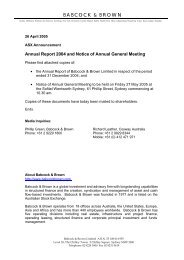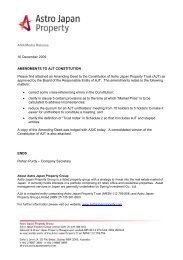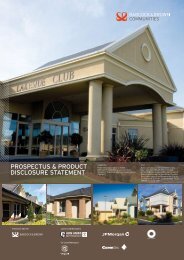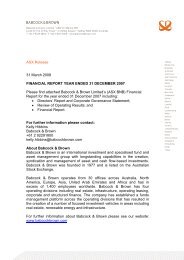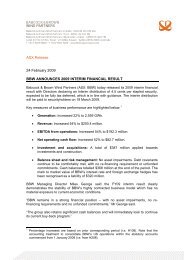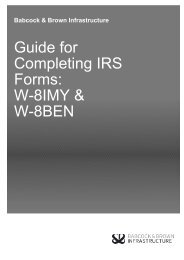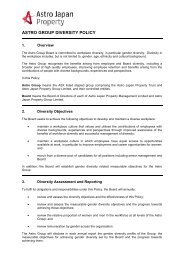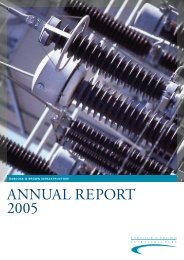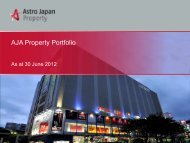Lead Manager
babcock & brown limited prospectus.pdf - Astrojapanproperty.com
babcock & brown limited prospectus.pdf - Astrojapanproperty.com
- No tags were found...
Create successful ePaper yourself
Turn your PDF publications into a flip-book with our unique Google optimized e-Paper software.
BABCOCK & BROWN PROSPECTUS<br />
(d)<br />
Financial Instruments and Hedging – Under AGAAP, it is permissible to hold certain financial<br />
instruments at cost (for example, equity investments not held for trading purposes). Under Australian<br />
IFRS, broadly all financial instruments other than debt and investments held to maturity must be held at<br />
fair value. Fair value adjustments are made through equity when the underlying asset has been<br />
designated as available for sale and through profit and loss for derivatives, trading assets and where the<br />
reporting entity elects to reflect the adjustment in this manner.When a financial instrument designated<br />
as available for sale is sold, any cumulative fair value adjustments reflected in equity in respect of that<br />
instrument are released through profit and loss. Unless specifically identified otherwise, Babcock &<br />
Brown intends to designate its financial instruments as available for sale.<br />
Under AGAAP, where a derivative is held to hedge a forecast transaction, gains and losses on those<br />
instruments are deferred and brought to account in the same period as the hedged transactions. Under<br />
Australian IFRS, derivatives may only be classified as hedges of forecast transactions where hedge<br />
designation, documentation and effectiveness tests can be met. If these tests are satisfied, then the<br />
hedging derivative is measured at fair value and gains and losses are reflected directly in equity until the<br />
hedged transaction occurs when they are released to profit and loss. For fully effective hedges, this results<br />
in a profit and loss outcome similar to AGAAP. However, to the extent that hedges do not satisfy the<br />
above tests then all or some of the gain or loss is immediately reflected in profit and loss.<br />
(e)<br />
(f)<br />
Non-current assets held for sale – AGAAP requires that all non-current assets with limited useful lives<br />
be depreciated over that useful life. Australian IFRS provides that where there is a clear intention to sell<br />
a non-current asset within 12 months and that non-current asset is designated as held for sale, no further<br />
depreciation should be provided.<br />
Share Based Payments – Under AGAAP there is no requirement to recognise an expense in respect of<br />
Share based payments. Public companies are required to disclose the value of equity instruments granted<br />
to directors and some entities have recognised an expense for this amount but there is no uniformity of<br />
practice and no requirement to recognise an expense.<br />
Under Australian IFRS, where an equity instrument is granted to an employee, the value of that<br />
instrument must be determined at the date of grant and that value must be expensed on a pro rata basis<br />
between the date of grant and the date the instrument fully vests with the employee.<br />
(g)<br />
Comparative Period – Under AGAAP, the consolidated statutory financial statements of the Group for<br />
2004 will only include the results of operations for the period from the IPO date to 31 December 2004.<br />
Australian IFRS will apply for the year ending 31 December 2005 and Australian IFRS requires that a<br />
comparative period be presented in the consolidated financial statements at that date. As noted under (a)<br />
above, under Australian IFRS, BBH is the deemed parent of the Babcock & Brown Group following the<br />
IPO. As BBH existed for all of 2004, the comparative period in the 2005 financial statements will be the<br />
full year ending 31 December 2004 rather than the abridged period under AGAAP.<br />
129



